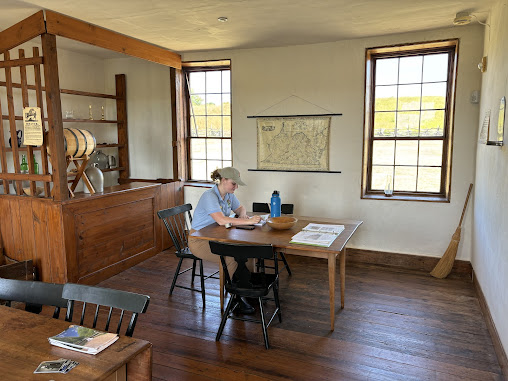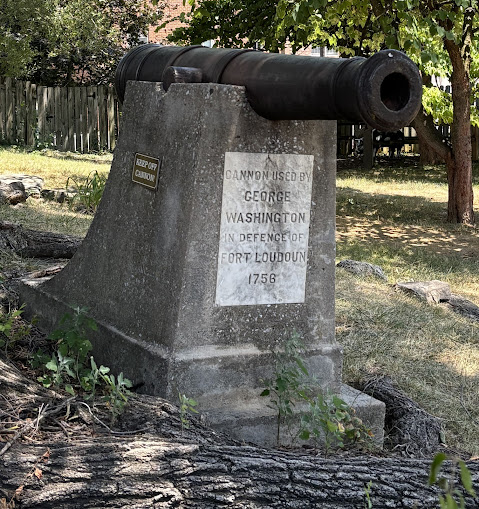We took a day to visit a couple of other sites.
Visitor Center
The name of the battle has caused controversy since 1861. The Union Army frequently named battles after significant rivers and creeks that played a role in the fighting; the Confederates generally used the names of nearby towns or farms. The U.S. National Park Services uses the Confederate name for its national battlefield park, but the Union name (Bull Run) is used by many.
Outside the house, you can see the grave of Judith Henry and others who were killed nearby.
Judith's headstone (in the middle) reads:
The idea for the monument came out of preparations for the 75th anniversary of the battle in 1936, and the General Assembly of Virginia appropriated $25,000 for the purpose of erecting a monument to Jackson. The Virginia Museum of Fine Arts was commissioned to conduct a national sculpture competition for the design of the statue. The Jackson monument was unveiled and dedicated in 1940.
In addition to the damage caused by the battle, the soldiers left a unique mark on the house. Two wounded soldiers of the 5th New York Infantry carved their names into the wood floor of an upstairs bedroom.
Cork Street Tavern is located near the Old Town Mall in historic downtown. The Tavern is housed in an 1830s structure that was shelled many times during the Civil War.
In a letter to his wife shortly after he arrived, Jackson commented:
Phew, that was a long day.At the First Battle of Manassas, the terms Blue and Gray were hardly synonyms for North and South. Soldiers fought in more than 200 different "uniforms". The Stars and Stripes of the Union flag were stitched in red, white, and blue - but so was the Confederate First National Flag. When the flags hung limply on a windless day, or in the dust and smoke of battle, they were almost indistinguishable.
Spring Hill Farm - known now simply as Henry Hill - lay fallow and overgrown in the summer of 1861. Inside the home, 84 year old Judith Henry remained bedridden, too old to work the land that had been in her family for more than a century. She shared the home with her daughter, Ellen, and a hired teenage slave, Lucy Griffin, who assisted with domestic chores.
The Battle of Bull Run culminated on the Henry property. Unaware of civilians inside, Federal artillery fired on the dwelling to drive away Confederate sharpshooters. The cannon fire crashed through the house, mortally wounding Mrs. Henry, the battle's only known civilian fatality. By day's end the family matriarch was dead, the house in ruins, and the surrounding landscape forever defined by the events of the day.
Following the war, the Henry family constructed a new home near the site of the original war time structure. Built in 1870, with an addition in 1884, the current structure remained in the Henry family until the early 1920s. The house then served as the first museum and visitor center at Manassas Battlefield.
"Killed near this spot by the explosion of shells in her dwelling during the Battle of the 21st of July, 1861. When killed she was in her 85th year and confined to her bed by the infirmities of age. Her husband Dr. Isaac Henry was a Surgeon in the United States Navy on board the frigate Constellation, Commanded by Com. Truxton, one of the six Captains appointed by Washington in the organization of the Navy, 1794. Our Mother through her long life, thirty five years of which were spent at this place, was greatly loved and esteemed for her kind, gentle Christian spirit."
One of the earliest endeavors to remember the fallen occurred soon after the war concluded. Union troops, stationed at nearby Fairfax Court House, many of whom had recently served on burial duty at the battlefield, recognized the need for a fitting memorial to the Federal dead at First Manassas. With the approval of their officers and the authorization of the government, and in one of their final acts before discharge, the soldiers erected the Bull Run (AKA Patriots) monument. Construction took nearly three weeks and was completed in June, 1865. It remains one of the oldest monuments on any Civil War battlefield.
The large bronze equestrian statue of Brigadier General Thomas Jonathan Jackson commemorates his role in the Confederate victory at First Bull Run/Manassas. It was here on the plateau of Henry Hill where Jackson received his famous nickname "Stonewall" as his brigade of Virginians made a determined stand against the Union advance which proved critical to the Confederate victory later in the day.
THERE STANDS JACKSON LIKE A STONE WALL
The First Battle of Bull Run/Manassas demonstrated that the war would not be won by one grand battle, and both sides began preparing for a long and bloody conflict. The battle also showed the need for adequately trained and experienced officers and men. One year later, many of the same soldiers who had fought at First Bull Run, now combat veterans, would have an opportunity to test their skills on the same battlefield at the Second Battle of Bull Run/Manassas.
A stop at Stone House. Tax records and historical accounts do not specify exactly when the Stone House was built but rather provide pieces of information about structures built on or near the lot. Earliest tax records show possible construction in 1828 by John Lee, however more recent investigations suggest that it was built in 1848 by Thomas Otway Clarke.
In July 1861, Confederate soldiers utilized the house for cover. During the mid-day lull, skirmishing occurred in the vicinity of the house before shifting southward to Henry Hill. As the battle progressed, the house filled with wounded soldiers. Following the Federal retreat from the battlefield, pursuing Confederate soldiers captured many Federal soldiers in the house. Following the battle, an assistant surgeon was permitted to treat the wounded. The house operated as a field hospital for several days.
During the Battle of Second Manassas, Federal commander John Pope established his headquarters on nearby Buck Hill, just north of the house. The house was again used as a place to care for wounded soldiers. On the third day of the battle (August 30, 1862), the Stone House came under heavy fire from Confederate artillery nearby.
There was a guide there to answer questions.
And we looked around.
The Fauquier and Alexandria Turnpike bridge over Bull Run, known simply as "the Stone Bridge" was originally built in 1825. Its ability to carry traffic across the steep sided stream even at times of high water gave the Stone Bridge a key role during the Civil War.
The first shots of the First Battle of Manassas flew over the bridge but there was little more than heavy skirmishing in its vicinity on July 21, 1861. On March 9, 1862, when the Confederate army evacuated their winter camps in Centreville and Manassas, the Stone Bridge was blown up to prevent its use by the Union forces that soon occupied the area.
Union Army engineers eventually constructed a temporary wooden span across Bull Run and after suffering another costly defeat at Second Manassas (August 28-30, 1862) Union forces used the bridge as their primary line of retreat. In the early hours of August 31, the bridge was destroyed by the Union Army.
Photo by George Bernard, available through Library of Congress
By 1884, the Stone Bridge was fully rebuilt. The new bridge, very similar to the original bridge, remained open to traffic until 1926. In that year the road was realigned and a modern highway bridge constructed just downstream. In 1959 the National Park Service acquired the Stone Bridge.
From there we drove to Winchester.
During the Revolutionary War, the Virginia House of Burgesses chose local resident and French and Indian War veteran Daniel Morgan to raise a company of militia to support General George Washington's efforts during the Siege of Boston. He led the 96 men of "Morgan's Sharpshooters" from Winchester on July 14, 1775, and marched to Boston in 21 days. During the Civil War, as the Confederate and Union armies strove to control that portion of the Shenandoah Valley; therefore Winchester and the surrounding areas were the site of numerous battles. There is a lot of history in this little town. But first - lunch!
After lunch we found a few points of interest.
Cannon used by George Washington in defence of Fort Louon 1758
George Washington
In March of 1748, George Washington, at age sixteen, arrived in Winchester, then called Frederick Town.
During the next four years, he worked as a surveyor throughout the colonial Virginia frontier.
And then on to a Civil War site.
The Gothic Revival style house was built in 1854 by local dentist William Fuller, who named it "Alta Vista" for its scenic view over open hillsides facing east across Winchester. In 1856, Fuller sold it to Lieutenant Colonel Lewis Tilghman Moore, commander of the 31st Virginia Militia. Later, Moore offered his home to serve as headquarters for Major General Thomas "Stonewall" Jackson. Jackson moved into the house in November 1861, shortly after taking command of the Valley District of the Department of Northern Virginia. Jackson was joined by his wife, Mary Anna, in December, 1861. From this house, Jackson planned his Shenandoah Valley defenses and campaign. The Jacksons lived in the house until March 1862 when the General left Winchester to begin his Valley Campaign.
While living there, the Jacksons became very fond of the people and culture of Winchester and referred to it as their "winter home", hoping to settle there after the Civil War.
In a letter to his wife shortly after he arrived, Jackson commented:
"The situation is beautiful, the building is of a cottage style and contains six rooms. I have two rooms, one above the other. The lower room, or office, has a matting on the floor, a large fine table, six chairs, and a piano. The walls are papered with elegant gift paper. I don't remember to have ever seen a more beautiful papering, and there are five paintings hanging on these walls....The upper room is neat, but not a full story and....remarkable for being heated in a peculiar manner, by a flue from the office below. Through the blessing of our ever-king Heavenly Father, I am quite comfortable." Letter from Jackson to his wife, Anna, November 16, 1861.

































No comments:
Post a Comment